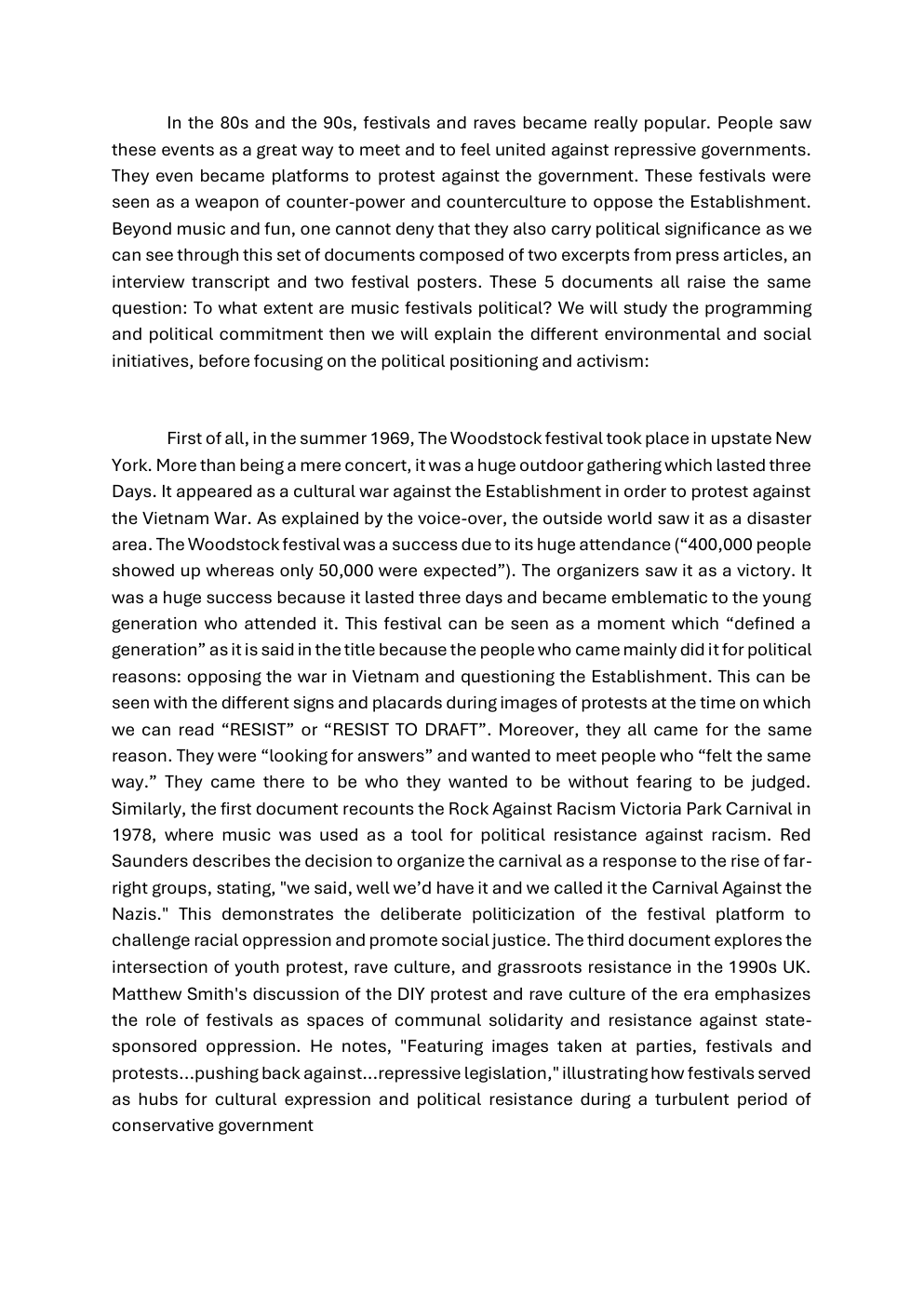In the 80s and the 90s, festivals and raves became really popular.
Publié le 11/06/2024
Extrait du document
«
In the 80s and the 90s, festivals and raves became really popular.
People saw
these events as a great way to meet and to feel united against repressive governments.
They even became platforms to protest against the government.
These festivals were
seen as a weapon of counter-power and counterculture to oppose the Establishment.
Beyond music and fun, one cannot deny that they also carry political significance as we
can see through this set of documents composed of two excerpts from press articles, an
interview transcript and two festival posters.
These 5 documents all raise the same
question: To what extent are music festivals political? We will study the programming
and political commitment then we will explain the different environmental and social
initiatives, before focusing on the political positioning and activism:
First of all, in the summer 1969, The Woodstock festival took place in upstate New
York.
More than being a mere concert, it was a huge outdoor gathering which lasted three
Days.
It appeared as a cultural war against the Establishment in order to protest against
the Vietnam War.
As explained by the voice-over, the outside world saw it as a disaster
area.
The Woodstock festival was a success due to its huge attendance (“400,000 people
showed up whereas only 50,000 were expected”).
The organizers saw it as a victory.
It
was a huge success because it lasted three days and became emblematic to the young
generation who attended it.
This festival can be seen as a moment which “defined a
generation” as it is said in the title because the people who came mainly did it for political
reasons: opposing the war in Vietnam and questioning the Establishment.
This can be
seen with the different signs and placards during images of protests at the time on which
we can read “RESIST” or “RESIST TO DRAFT”.
Moreover, they all came for the same
reason.
They were “looking for answers” and wanted to meet people who “felt the same
way.” They came there to be who they wanted to be without fearing to be judged.
Similarly, the first document recounts the Rock Against Racism Victoria Park Carnival in
1978, where music was used as a tool for political resistance against racism.
Red
Saunders describes the decision to organize the carnival as a response to the rise of farright groups, stating, "we said, well we’d have it and we called it the Carnival Against the
Nazis." This demonstrates the deliberate politicization of the festival platform to
challenge racial oppression and promote social justice.
The third document explores the
intersection of youth protest, rave culture, and grassroots resistance in the 1990s UK.
Matthew Smith's discussion of the DIY protest and rave culture of the era emphasizes
the role of festivals as spaces of communal solidarity and resistance against statesponsored oppression.
He notes, "Featuring images taken at parties, festivals and
protests...pushing back against...repressive legislation," illustrating how festivals served
as hubs for cultural expression and political resistance during a turbulent period of
conservative government
Moreover, the repressive government of the 90s led people to protest during
festivals.
Social repression and major recession made people want to unite and fight
back during festivals and rave parties.
The traveller community become more and more
popular and people saw festivals as a means to denounce the inequalities created by the
government.
The Glastonbury music festival can be defined as a political festival as it is
said in the article “the most overtly political act at a festival this summer was at
Glastonbury” (ll.
22-23) for the following reasons: the money raised goes to charities, it
becomes a self-sufficient world, they have banned the sale of Native American
headdresses (avoid cultural appropriation), a space is entirely dedicated to left wing
music, talks ...
If the Glastonbury Festival is taken as an example, one can notice that the
audience are mainly composed of “white middle-class” and “marginalised” people are
completely absent.
It is a bit absurd/paradoxical because this music festival is left-wing.
If a music festival is a political one, it is important for it to have a real and permanent
impact but right now it’s impossible to measure the impact on society.
As the same way,
the Rock Against Racism carnival was created under the impulsion of the Anti-Nazi
League and Rock Against Racism due to a heavy political context: the coming general
election and local elections in May 1978.The purpose of the concert was to find tactics
to resist and find a common strategy against the National....
»
↓↓↓ APERÇU DU DOCUMENT ↓↓↓
Liens utiles
- The impact of social media on our societies through the changes in lifestyles, diversity and human rights.
- Encyclopedia of Philosophy: The Doubt and the Cogito - DESCARTES
- The Buddha of suburbia
- the stolen generation
- Is there one side of the coin in the myth of the frontier?

































